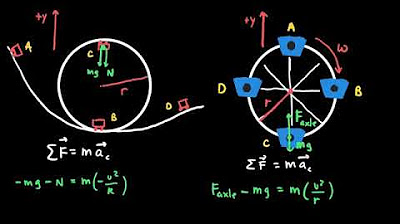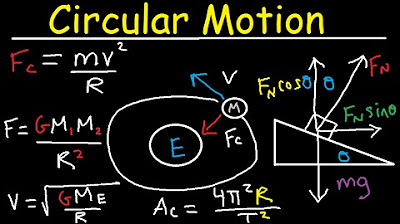13.4a Orbital Mechanics | A2 Gravitational Fields | Cambridge A Level Physics
TLDRThis lecture delves into orbital mechanics, focusing on the circular motion of satellites around a planet. It explains how gravitational force provides the necessary centripetal force for circular orbits and how this relationship affects the satellite's velocity and energy. The concept of escape velocity is introduced, highlighting the difference between orbital speed and the speed required to break free from Earth's gravitational pull. The lecture reinforces the importance of understanding these principles for satellite navigation and space travel.
Takeaways
- 🌌 Understanding Orbits: The lecture focuses on orbital mechanics, specifically the motion of satellites around celestial bodies like planets and moons.
- 📈 Circular Orbits: The chapter primarily discusses circular orbits for simplicity, acknowledging that elliptical orbits exist but are beyond the A-level curriculum.
- 🚀 Gravitational Force and Centripetal Force: The gravitational force provides the necessary centripetal force for a satellite to maintain its circular orbit.
- 🎯 Orbital Speed Equation: The velocity (v) of a satellite in orbit is given by the formula v = √(GM/r), where G is the gravitational constant, M is the mass of the planet, and r is the radius of the orbit.
- 🔋 Kinetic and Potential Energy: The total energy of a satellite in orbit is the sum of its kinetic energy (KE) and potential energy (PE), with PE being negative due to gravity.
- 📉 Negative Total Energy: The total energy of a satellite in orbit is negative, indicating that it lacks the energy to escape Earth's gravitational field.
- 🌍 Escape Velocity: To overcome Earth's gravity, a satellite must reach a minimum velocity known as the escape velocity (ve), calculated by √(2GM/r).
- 🔄 Energy Graphs: Changes in a satellite's radius affect its kinetic and potential energies, with closer orbits requiring higher velocities and energies to maintain stability.
- 🚫 Spiral In: Insufficient velocity or energy can cause a satellite to spiral inwards towards the Earth, leading to a catastrophic end.
- 🌟 Energy Conservation: The total mechanical energy of a satellite (KE + PE) must be zero at infinity for it to escape Earth's gravitational pull successfully.
- 🛰️ Rocket Science and Energy: The minimum kinetic energy required to escape Earth's gravity is a critical factor in rocket design and space travel.
Q & A
What is the primary focus of this lecture?
-The primary focus of this lecture is on orbital mechanics, specifically the motion and behavior of satellites in circular orbits around a planet.
What is the significance of the gravitational field strength in satellite orbits?
-The gravitational field strength is significant because it determines the navigation and stability of a satellite's orbit. It is the force that provides the necessary centripetal force to keep the satellite in its circular path.
How is the centripetal force provided in a circular orbit?
-In a circular orbit, the centripetal force is provided by the gravitational force between the satellite and the planet. This relationship can be expressed by equating the centripetal force (mv^2/r) with the gravitational force (G*(m*M)/r^2).
What is the orbital speed of a satellite?
-The orbital speed of a satellite is the velocity required for it to maintain a stable circular orbit. It is calculated using the formula v = sqrt(G*M/r), where G is the gravitational constant, M is the mass of the planet, and r is the radius of the orbit.
How does the kinetic energy of a satellite in orbit relate to its velocity?
-The kinetic energy (KE) of a satellite in orbit is directly related to its velocity by the formula KE = 0.5 * m * v^2, where m is the mass of the satellite and v is its velocity. The greater the velocity, the greater the kinetic energy.
What is the potential energy of a satellite in orbit?
-The potential energy (PE) of a satellite in orbit is given by the formula PE = -G*M*m/r, where G is the gravitational constant, M is the mass of the planet, m is the mass of the satellite, and r is the distance from the center of the planet to the satellite. The negative sign indicates that the potential energy is a 'depth' of energy, representing the work that would need to be done to move the satellite from its current position to infinity.
What does the total energy of a satellite in orbit signify?
-The total energy of a satellite in orbit is the sum of its kinetic and potential energies. A negative total energy indicates that the satellite is bound to the planet's gravitational field and does not have enough energy to escape. A positive total energy would mean the satellite has more than enough energy to escape the gravitational field.
What is the escape velocity, and how is it related to the orbital speed?
-The escape velocity (ve) is the minimum velocity a satellite needs to break free from the gravitational pull of a planet. It is calculated using the formula ve = sqrt(2*G*M/r). The escape velocity is greater than the orbital speed, meaning that an object must be traveling faster than its orbital speed to avoid being captured by the planet's gravity.
How does changing the radius of a satellite's orbit affect its kinetic and potential energies?
-If the radius of the orbit decreases, the gravitational force increases, requiring a greater centripetal force, which means an increase in the satellite's velocity and thus its kinetic energy. The potential energy also increases because it is more negative at closer distances to the planet. Conversely, as the radius increases, both the kinetic and potential energies decrease.
What is the significance of the total energy being zero at infinity?
-The significance of the total energy being zero at infinity is that it represents the point where the satellite has exactly enough energy to break free from the gravitational pull of the planet without having any excess energy left over. This is the minimum energy required for the satellite to 'escape' the gravitational field.
How does the concept of total energy relate to the ability of a satellite to escape Earth's gravitational field?
-The concept of total energy relates to the ability of a satellite to escape Earth's gravitational field in that the satellite must have a total energy that is equal to or greater than zero to overcome the gravitational potential energy. If the total energy is negative, the satellite is bound to Earth; if it is positive, the satellite can escape and travel to infinity.
Outlines
🌌 Introduction to Orbital Mechanics
This paragraph introduces the concept of orbital mechanics, specifically focusing on circular orbits. It begins with a discussion about the complexity of orbits using the example of a satellite orbiting the moon. The lecturer emphasizes the importance of understanding the gravitational field strength and its impact on the satellite's trajectory. The paragraph then transitions to a basic case study of a satellite orbiting a planet, using Earth and a satellite with mass 'm' as an example. Key concepts like centripetal force, linear tangential velocity (v), and the radius of the orbit (r) are introduced. The paragraph also derives the orbital speed equation (v = √(GM/r)), where G is the gravitational constant and M is the mass of the central body (Earth). The concept of potential and kinetic energy in the context of a satellite's orbit is briefly touched upon, setting the stage for a deeper exploration in the following paragraphs.
📈 Energy Graphs and Orbital Radius
In this paragraph, the lecturer delves into the relationship between a satellite's energy (both kinetic and potential) and its orbital radius. The discussion starts with a comparison of kinetic energy (KE) and potential energy (PE) at a specific radius, highlighting how changes in radius affect the gravitational force and the satellite's velocity. The concept of a satellite spiraling towards the Earth due to insufficient velocity is introduced. The paragraph then presents a graphical representation of how KE and PE change with the radius, emphasizing that the total energy (TE) of the satellite is negative, indicating that it cannot escape Earth's gravitational field. The concept of escape velocity is introduced, explaining that a satellite must have enough kinetic energy to overcome the negative potential energy to escape Earth's gravity.
🚀 Achieving Escape Velocity
This paragraph focuses on the calculation of the escape velocity, which is the minimum velocity required for a satellite to break free from Earth's gravitational pull. The lecturer explains that to reach infinity, the satellite's kinetic energy must be equal to the negative of its potential energy at Earth's surface. The escape velocity equation (VE = √(2GM/r)) is derived, and it is noted that the escape velocity is greater than the orbital speed, meaning that an object must exceed the orbital speed to escape Earth's gravity. The paragraph concludes with a discussion on the importance of having sufficient kinetic energy to overcome gravitational potential energy and the metaphorical 'debt' to Earth's gravity, emphasizing the need for a 'rocket' (kinetic energy) to 'pay off' this debt and achieve escape.
Mindmap
Keywords
💡Orbital Mechanics
💡Centripetal Force
💡Gravitational Field Strength
💡Circular Orbit
💡Linear Tangential Velocity
💡Orbital Speed
💡Kinetic Energy
💡Potential Energy
💡Total Energy
💡Escape Velocity
💡Energy Conservation
Highlights
The lecture focuses on orbital mechanics, particularly the case study of a simple satellite around a planet.
The satellite can be a moon or a man-made satellite, and the discussion revolves around circular orbits for A-level focus.
The concept of centripetal force provided by gravitational force is introduced, with the formula mv^2/r and gmm/r^2.
The orbital speed is derived as v = sqrt(gm/r), where 'm' is the mass of the satellite, 'r' is the radius of the orbit, and 'g' is the gravitational constant.
The kinetic energy (KE) of the satellite is calculated as KE = 1/2 mv^2, relating to the satellite's mass and velocity.
The potential energy (PE) of the satellite is given by PE = -gmm/r, highlighting the negative sign indicating attraction towards the Earth.
The total energy of the satellite is the sum of its kinetic and potential energies, resulting in a negative value indicating the satellite's inability to escape Earth's gravitational field.
A satellite in Earth's orbit has a negative total energy, meaning it lacks the energy to escape Earth's gravitational pull.
The concept of escape velocity is introduced, explaining the minimum velocity needed for a satellite to break free from Earth's gravity.
The escape velocity is derived as ve = sqrt(2gm), showing its dependence on the gravitational constant and the mass of the central body.
The importance of the satellite having sufficient kinetic energy to overcome negative gravitational potential energy is emphasized for escaping Earth's orbit.
The total energy of the satellite at infinity is zero, indicating that it has escaped the gravitational field and no longer owes 'energy debt' to Earth.
The relationship between the rocket's total energy and its ability to escape Earth is discussed, with zero total energy being the threshold for escape.
The lecture concludes with a reminder of the importance of kinetic energy in space travel and the concept of 'paying back' Earth's gravitational field.
Transcripts
Browse More Related Video

AP Physics 1 Circular Motion and Gravitation Review

Gravitational Fields - A Level Physics

Uniform Circular Motion - IB Physics

The Gravity of the Situation: Crash Course Astronomy #7

Centripetal force and acceleration intuition | Physics | Khan Academy

Centripetal Acceleration & Force - Circular Motion, Banked Curves, Static Friction, Physics Problems
5.0 / 5 (0 votes)
Thanks for rating: